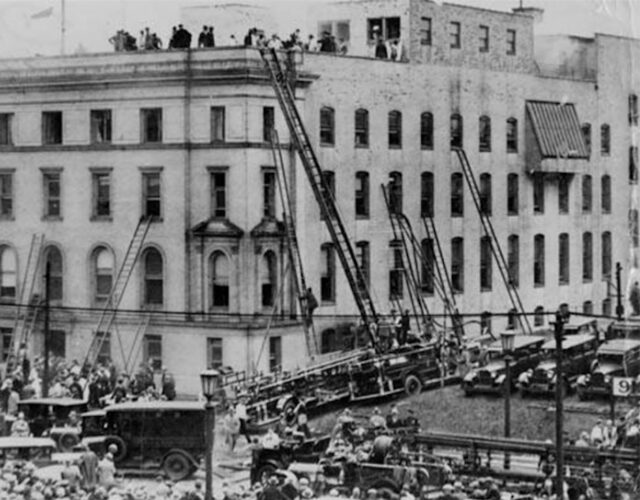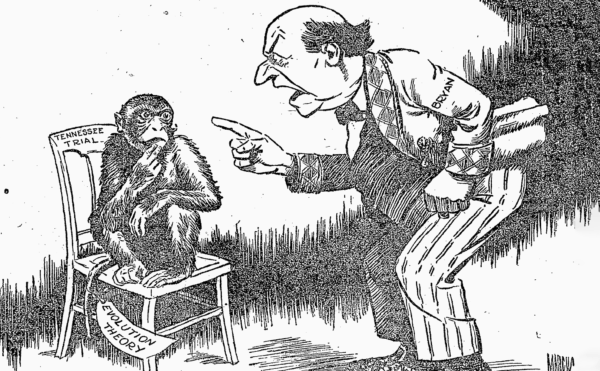In this episode of The Disappearing Spoon, Sam Kean breaks down the history of nitrocellulose. This thick, transparent liquid was the world’s first plastic and could be shaped into anything, including billiard balls and photography film. With nitrocellulose film, you could run reels of pictures together quickly, which gave birth to the first movies.
The only fatal flaw with this plastic is that it’s also extremely combustible—so much so that it can burn underwater once it gets going. This led to notable tragedies in movie theaters, as well as in hospitals that used nitrocellulose X-rays such as the Cleveland Clinic Hospital, where 122 people died in a fire in 1929.
Credits
Host: Sam Kean
Senior Producer: Mariel Carr
Producer: Rigoberto Hernandez
Audio Engineer: Jonathan Pfeffer
Photo: Cleveland Memory
Transcript
Imagine it’s 1909 in Brooklyn, New York, about 9:00 a.m. You’re walking along through an Italian neighborhood, munching on an apple for breakfast. Suddenly, you hear something.
It’s coming from the next block over. You look up, and above the roofline, you can already see smoke—thick brown clouds. You start running, but you know immediately where it’s coming from. People have been calling that factory a deathtrap for years.
You rush up, and sure enough, the factory is engulfed in flames—from basement to roof. You see a young Black man hauling a limp, burned body out the door. Then above you, more screams. You look up, and see people at the windows on the third floor. You yell at them to jump—jump!
Then you realize that they’re trapped behind bars.
In fact, every window at the factory has bars, to keep burglars out. But right now, those safety bars have trapped people inside. They’re facing death—and they know it. They’re screaming and shaking the bars, like rabid apes in a cage.
Luckily, people start arriving with ladders from another, nearby factory. Another person rushes up with sledgehammers. They hand one to you. And while someone holds a ladder at the bottom, you scamper up toward one of the barred windows. Other men do the same at other windows.
At the window, you come face to face with two women—a short redhead, and a tall brunette. They can’t be more than 19 years old. Their eyes are wide, and they’re screaming. Their hands are bloody from where they’ve broken the glass. You promise to free them.
But it’s hard to get a good swing on a ladder. There’s also toxic smoke billowing in your face. You brace your feet and do what you can. <HAMMERBLOWS> You rain blow after blow on the iron bars.
It does no good. The iron is too thick, bolted to the brick façade. You can hardly breathe anyway, and you’re getting lightheaded. But the women are still screaming—until a whoosh of flame erupts behind them.
The draft is so strong you drop the sledgehammer; it clatters below. You manage to catch yourself before falling. But when you’re steady again, the screams have stopped. You can no longer see the women at the window.
There’s nothing to do but climb down, hacking and coughing. From the looks of it, none of the other men succeeded in knocking open the other windows. Every last person trapped inside seems doomed to die.
Now, that scene I just described was partly invented. But it’s all based on real details, from a fire in a factory in Brooklyn in 1909. People really did get trapped behind barred windows, and several people really did try to smash the bars open with sledgehammers.
Worst of all, ten people really did die horribly inside, including several young women burned alive. And more probably would have died if not for a brave young Black man named Oliver Davis, who dashed inside and pulled multiple people from the inferno—including the factory’s owner.
In some ways, this fire remains a mystery even today. We have no idea what started it and sent the factory up in flames. A cigarette? A spark from a hammered nail? Bad electrical wiring?
But in other ways, this fire was utterly, wretchedly predictable. Neighbors had been whispering about the place as a firetrap for years. Because they knew that it made one of the most dangerous industrial substances on earth.
So what was this substance? You might guess gunpowder, or phosphorus for matches. Maybe kerosene. But no. This substance was worse. It was none other than the world’s very first plastic.
The story of this deadly plastic starts in the 1840s, when a German-Swiss chemist had a little booboo in the lab. But, it turned out to be one of those lucky mistakes that make history swerve.
One day, the chemist knocked over a beaker that contained several different acids, including nitric and sulfuric acid. These acids are caustic stuff, and he probably cursed his clumsiness. Then he mopped them up with a cotton rag. Afterward, he hung the cotton rag near a stove to dry.
Later, just by chance, a spark from the stove hit the rag—and whoosh. <QUICK-FLAMES> It instantly burst into flame. It was a scary moment.
But once the chemist caught his breath, he realized that the way the cloth had burned was actually pretty interesting. Usually rags start burning at one spot, and the flame slowly eats its way outward. That’s not what happened here. Instead, the whole rag ignited at once—one big flash. It was a completely new type of flammable material.
Eventually this mixture of cotton and certain acids came to be called guncotton. It looked harmless—fluffy white bits, like bites of cotton candy. But boy, did it pack a punch when it was burned.
For a while, guncotton was a huge hit in the military. It was six times more powerful than gunpowder, which made it far better for propelling bullets and mortar shells. Even better, guncotton didn’t release smoke. In most old battles, there was so much smoke after five minutes that soldiers couldn’t even see what they were aiming at. Guncotton eliminated that problem completely.
People in other industries loved guncotton, too. Miners in quarries used it to blast open rocks. Science-fiction writer Jules Verne even used guncotton in one of his books to propel a rocket to the Moon.
Still, however much potential it had, guncotton never lived up to its promise. It was simply too unstable for everyday use. Every time you transported it, you risked a huge explosion. Even storing it was dangerous. So eventually scientists developed other smokeless explosives, and within a few decades, guncotton had been phased out.
But—where the military feared to tread, people with get-rich-quick schemes rushed right in.
Chemists soon discovered that you could dissolve the white tufts of guncotton in certain liquids. Usually this liquid was a combination of alcohol, ether, acetone, and/or camphor. Imagine the harsh chemical smell. But the result was a thick liquid that was completely transparent. People called it cellulose nitrate, or nitrocellulose.
This nitrocellulose was the world’s first plastic. You could just pour the liquid into a mold, and it would dry in whatever shaped you wanted. Untreated, it was soft and flexible. But you could easily make it stiff and hard by adding other chemicals. And if you wanted different colors, it was very easy to dye. Pretty much a miracle substance.
At first people used nitrocellulose as a substitute for natural materials. People made fake ivory teeth and billiard balls, fake amber beads, fake tortoiseshell combs. There was also a knockoff fabric called “mother-in-law silk,” for when, um, only the best would do.
Eventually, nitrocellulose expanded to new industries—especially photography. The first photographers captured images on glass plates, which were heavy and breakable. But chemists realized that they could spread nitrocellulose on flat surfaces, and it would dry to form thin, transparent sheets that were perfect for photography. In contrast to heavy, breakable glass plates, this film was light and flexible. And it captured rich, detailed images.
Best of all, with flexible film, you could run reels of pictures together very quickly. Hence, the first motion pictures were born—the first movies. <“Action!”>
Now, nitrocellulose wasn’t the only plastic around in the late 1800s and early 1900s. You also had latex and Bakelite, among others. But in many ways, nitrocellulose was king. It seemed poised to revolutionize the world.
There was just one problem. Nitrocellulose was still made from guncotton. And all the energy in the chemical bonds of guncotton—the same energy that once hurled bullets and mortar shells—was now lurking inside billiard balls and movie reels. And every so often, all that energy came roaring out.
The stories are legion. Combs catching fire and burning people’s hair off. Or people with false ivory teeth huddling too near a stove and—<POP>—a tooth exploding inside their mouths.
My favorite tale involved billiard balls made of fake ivory. Sometimes in bars or saloons, two pool balls would collide hard and explode. <BREAK, BANG> Frankly this was only a minor danger to the players. The real trouble started afterward, when every shady character in the saloon would hear a bang—and immediately whip his gun out, itching to shoot.
Other cases were truly tragic. We already heard about the deadly fire in the Brooklyn factory. And if you’d like to hear more about that fire, including the heroic Black man at the center of the rescue efforts, Oliver Davis, then check out the bonus episode at patreon.com/disappearingspoon. It’s a thrilling tale.
To me, the saddest stories involve movie theaters. Imagine it’s the early 1900s, and you’re experiencing the magic of cinema for the first time. It’s probably something simple onscreen. Maybe a train passing by. Or someone dancing. Or a silent scene from Shakespeare. But to you, it’s a miracle. Moving pictures! What a time to be alive!
Unfortunately, movie projectors needed powerful lightbulbs to illuminate the strips of nitrocellulose film. Those lightbulbs would get piping hot. And not infrequently, the film would catch fire.
For this reason, projectionists had to stay inside the booths at movie theaters at all times. Many theaters even installed toilets and sinks in the booths, so that projectionists never had any reason to leave, not for a second.
But frankly, if a fire did break out, there wasn’t much the projectionist could do. That’s because nitrocellulose is a truly diabolical material. If a fire broke out in a projection booth today, the sprinklers would take care of it; even a bucket of water could work. But back then, those measures would have failed.
You see, a burning fire needs three things. A spark to kick things off; some fuel to burn; and oxygen, which feeds the fire and keeps it going. Water puts out fire by depriving the fuel of oxygen.
And for 99 percent of fuels, water works great. But due to its chemical makeup, nitrocellulose actually releases its own oxygen as it burns. That is, as the nitrocellulose molecules break down chemically, they release oxygen gas as a byproduct. And because nitrocellulose releases its own oxygen, it can actually burn underwater once it gets going. I’m not kidding. It’s truly diabolical stuff.
As a result, sprinklers or buckets of water in movie theaters were useless. This made fires in projection booths impossible to control—especially if there were other flammable reels sitting around. The results were tragic. A movie fire in Ireland once killed 48 people. Another killed 69 children in Scotland. Still another in Paris killed 126 people.
And that was fresh nitrocellulose Old nitrocellulose is even more dangerous.
As nitrocellulose get older, it turns yellow and brittle and breaks into pieces. And as it falls apart, the temperature at which it catches fires—called the flashpoint—drops rapidly. In extreme cases, the flashpoint dips down to 120 degrees. At that flashpoint, all it takes is a summer heatwave in a building without good ventilation, and whoosh! The film will spontaneously combust. It reminds me of those old Inspector Gadget cartoons.
And the danger of old nitrocellulose doesn’t stop with fire. There’s also poison gas.
Take the story of the Cleveland Clinic hospital in Ohio. By the late 1920s, the hospital had accumulated 6000 pounds’ worth of old nitrocellulose x-rays in its basement. And one day in May 1929, something ignited them. It could have been a broken steam pipe, an electric bulb, someone smoking. Regardless, the basement quickly turned into an inferno.
But unlike with the Brooklyn factory, the danger in Cleveland wasn’t the fire itself. When it burns, nitrocellulose releases gases like carbon monoxide, nitrous oxide, and nitrous dioxide. Collectively, these gases smell like concentrated brown smog. They suffocate like smog as well.
When the fire escaped the hospital basement, a plume of hot, expanding gas rushed right up the central atrium to the fourth floor and blew out the skylight. <CRASH> Then, brown clouds of poison began seeping into offices and patient rooms on other floors. Most of the people inside could have escaped the fire, but they ended up choking and slumping over due to the gas.
There were 225 doctors, nurses, and patients inside the hospital when the fire started. As for who lived or died, it was essentially a coin flip. Of those 225 people, 122 died, just over half. One writer compared the conditions inside to gas-warfare attacks during World War One.
After the Cleveland fire, not to mention hundreds of other disasters over the years, regulators finally decided that nitrocellulose wasn’t worth the risk. Scientists developed other plastics to replace it, especially cellulose acetate—a compound that’s no more flammable than paper. By the 1950s, nitrocellulose had mostly been phased out.
But that doesn’t mean we’ve put this deadly plastic behind us. Nitrocellulose still causes trouble today. Certain household items are still made of nitrocellulose, like guitar picks and ping-pong balls. Those items aren’t going to spontaneously combust, but they are surprisingly flammable.
There are also innumerable objects made of nitrocellulose that museums want to preserve because they’re culturally important. The first fake billiard balls, for instance.
The biggest conservation headache involves nitrocellulose movie film. Scholars estimate that there’s at least 187 million feet of old nitrocellulose film worldwide, and museum collections of this film have caught fire as late as 2003.
Even sadder, because of both fires and the natural decay of nitrocellulose, whole movie careers have vanished forever—including the careers of early Native American stars like James Young Deer and Mona Darkfeather. In fact, just one-fourth of all silent films survive in full today. And the first-ever depictions of vampires, werewolves, and zombies onscreen no longer exist.
When we worry about plastics today, we often fear that they’re too durable. After all, water bottles and shopping bags and other junk now litter everywhere from the top of Mt. Everest to the bottom of the ocean. And they’re not going to break down anytime soon.
But if you think plastics are bad now, well—thank your lucky stars that your comb isn’t going to spontaneously combust, or that your local movie theater won’t go up in smoke. Plastic durability is a problem, certainly. But plastic volatility was a curse all its own.




